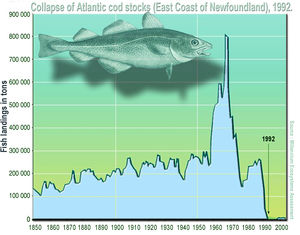In an increasingly human-dominated world, where most of us seem oblivious to the liquidation of Earth’s natural resource capital, exploitation of biological populations has become one of the most important threats to the persistence of global biodiversity. Many regional economies, if not entire civilizations, have been built on free-for-all extractive industries, and history is littered with examples of boom - and - bust economic cycles following the emergence, escalation and rapid collapse of unsustainable industries fuelled by raw renewable resources. The economies of many modern nation -states still depend heavily on primary extractive industries, such as fisheries and logging, and this includes countries spanning nearly the entire spectrum of per capita Gross National Product (GNP), such as Iceland and Cameroon. Human exploitation of biological commodities involves resource extraction from the land, freshwater bodies or oceans, so that wild animals, plants or their products are used for a wide variety of purposes ranging from food to fuel, shelter, fiber, construction materials, household and garden
items, pets, medicines, and cosmetics.
items, pets, medicines, and cosmetics.
Overexploitation occurs when the harvest rate of any given population exceeds its natural replacement rate, either through reproduction alone in closed populations or through both reproduction and immigration from other populations. Many species are relatively insensitive to harvesting, remaining abundant under relatively high rates of offtake, whereas others can be driven to local extinction by even the lightest levels of offtake. Fishing, hunting, grazing, and logging are classic consumer-resource interactions and in natural systems such interactions tend to come into equilibrium with the intrinsic productivity of a given habitat and the rates at which resources are harvested. Furthermore, efficiency of exploitation by consumers and the highly variable intrinsic resilience to exploitation by resource populations may have often evolved over long periods. Central to these differences are species traits such as the population density (or stock size), the per capita growth rate of the population, spatial diffusion from other less harvested populations, and the direction and degree to which this growth responds to harvesting through either positive or negative density dependence.
For example, many long-lived and slow -growing organisms are particularly vulnerable to the additive mortality resulting from even the lightest offtake, especially if these traits are combined with low dispersal rates that can inhibit population diffusion from adjacent unharvested source areas, should these be available. These species are often threatened by over hunting in many terrestrial ecosystems, unsustainable logging in tropical forest regions, cactus “rustling” in deserts, overfishing in marine and freshwater ecosystems, or many other forms of unsustainable extraction. For example, overhunting is the most serious threat to large vertebrates in tropical forests (Cunningham et al. 2009), and overexploitation, accidental mortality and persecution caused by humans threatens approximately one-fifth (19%) of all tropical forest vertebrate species for which the cause of decline has been documented [IUCN (International Union for Conservation of Nature) 2007]. Overexploitation is the most important cause of freshwater turtle extinctions (IUCN 2007) and the third-most important for freshwater fish extinctions, behind the effects of habitat loss and introduced species (Harrison and Stiassny 1999).
Thus, while population declines driven by habitatloss and degradation quite rightly receive a great deal of attention from conservation biologists (MEA 2006), we must also contend with the specter of the ‘empty’ or ‘half-empty’ forests, savannahs, wetlands, rivers, and seas, even if the physical habitat structure of a given ecosystem remains otherwise unaltered by other anthropogenic processes that degrade habitat quality. Overexploitation also threatens frogs: with Indonesia the main exporter of frog legs for markets in France and the US (Warkentin et al. 2009). Up to one billion wild frogs are estimated to be harvested every year for human consumption (Warkentin et al. 2009). I begin this chapter with a consideration of why people exploit natural populations, including the historical impacts of exploitation on wild plants and animals. This is followed by a review of effects of exploitation in terrestrial and aquatic biomes. Throughout the chapter, I focus on tropical forests and marine ecosystems because many plant and animal species in these realms have succumbed to some of the most severe and least understood overexploitation-related threats to population viability of contemporary times. I then explore impacts of exploitation on both target and non-target species, as well as cascading effects on the ecosystem. This leads to a reflection at the end of this chapter of resource management considerations in the real-world, and the clashes of culture between those concerned with either the theoretical underpinnings or effective policy solutions addressing the predicament of species imperiled by overexploitation.














0 comments:
Post a Comment